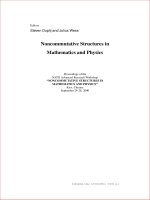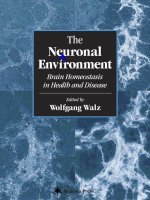- Trang chủ >>
- Khoa Học Tự Nhiên >>
- Vật lý
Magnetic Material Engineering - Chapter 6: Applications in Medical and Biology pot
Bạn đang xem bản rút gọn của tài liệu. Xem và tải ngay bản đầy đủ của tài liệu tại đây (586 KB, 33 trang )
Magnetic Material Engineering
Chapter 6:
Applications in Medical and Biology
Magnetic Material Engineering
Magnetic Material Engineering
Chapter 6: Applications in Medical and Biology
Magnetic nanoparticles
Magnetic Material Engineering
Chapter 6: Applications in Medical and Biology
Magnetic nanoparticles
Magnetic Material Engineering
Chapter 6: Applications in Medical and Biology
Magnetic nanoparticles
Magnetic Material Engineering
Chapter 6: Applications in Medical and Biology
Magnetic nanoparticles
Materials: Fe, Co, Ni, Gd
Spins of unfilled d-bands spontaneously
align parallel inside a domain below a
critical temperature T
C
(Curie) Laws:
B = H +4πχH
M = χH
χ: Susceptibility
Magnetic Material Engineering
Chapter 6: Applications in Medical and Biology
Magnetic nanoparticles
Hard Magnets: H
C
and M
rs
have high values
Magnetic Material Engineering
Chapter 6: Applications in Medical and Biology
Superparamagnetism - a size effect
Magnetic Material Engineering
Chapter 6: Applications in Medical and Biology
Superparamagnetism - a size effect
Superparamagnetism:
• high saturation magnetisation M
S
• no remanence M
R
= 0
Magnetic Material Engineering
Chapter 6: Applications in Medical and Biology
Superparamagnetism
The Néel relaxation in the absence of magnetic field
Normally, any ferromagnetic or ferrimagnetic material undergoes a transition
to a paramagnetic state above its Curie temperature. Superparamagnetism is
different from this standard transition since it occurs below the Curie
temperature of the material.
Superparamagnetism occurs in nanoparticles which are single domain. This is
possible when their diameter is below 3–50 nm, depending on the materials.
In this condition, it is considered that the magnetization of the
nanoparticles is a single giant magnetic moment, sum of all the individual
magnetic moments carried by the atoms of the nanoparticle.
Magnetic Material Engineering
Chapter 6: Applications in Medical and Biology
Superparamagnetism
Magnetic anisotropy is the direction dependence of a material's magnetic
properties.
In the absence of an applied magnetic field, a magnetically isotropic material
has no preferential direction for its magnetic moment while a magnetically
anisotropic material will align its moment with one of the easy axes.
Magnetic anisotropy is a prerequisite for hysteresis in ferromagnets: without
it, a ferromagnet is superparamagnetic.
Magnetic Material Engineering
Chapter 6: Applications in Medical and Biology
Magnetic anisotropy
• Are the magnetic properties same in all directions?
No
• It depends on the crystallographic direction in which the magnetic dipoles
are aligned
– Crystal anisotropy (Spin Orbit Coupling)
– Shape anisotropy
– Stress anisotropy
– Externally induced anisotropy
– Exchange anisotropy
• E = KVsin
2
θ (simplest form)
– K the effective uniaxial anisotropy energy per unit volume
– V particle volume
– θ angle between moments and easy axis
Magnetic Material Engineering
Chapter 6: Applications in Medical and Biology
Magnetic anisotropy
Magnetic Material Engineering
Chapter 6: Applications in Medical and Biology
Superparamagnetism
Because of the nanoparticle’s magnetic anisotropy, the magnetic moment has
usually only two stable orientations antiparallel to each other, separated by
an energy barrier.
The stable orientations define the nanoparticle’s so called “easy axis”.
At finite temperature, there is a finite probability for the magnetization to
flip and reverse its direction. The mean time between two flips is called the
Néel relaxation time τ
N
and is given by the following Néel-Arrhenius equation:
Magnetic Material Engineering
Chapter 6: Applications in Medical and Biology
Superparamagnetism
•
τ
N
is thus the average length of time that it takes for the nanoparticle’s
magnetization to randomly flip as a result of thermal fluctuations.
•
τ
0
is a length of time, characteristic of the material; its typical value is 10
−9
–10
−10
second.
•
K
is the nanoparticle’s magnetic anisotropy energy density and
V
its volume.
•
KV
is therefore the energy barrier associated with the magnetization moving from
its initial easy axis direction, through a “hard plane”, to the other easy axis direction.
•
k
B
is the Boltzmann constant and
T
is the temperature.
Magnetic Material Engineering
Chapter 6: Applications in Medical and Biology
Superparamagnetism - a size effect
Magnetic Material Engineering
Chapter 6: Applications in Medical and Biology
Superparamagnetism - a size effect
Magnetic Material Engineering
Chapter 6: Applications in Medical and Biology
Magnetic Nanoparticles
Magnetic Nanoparticles
Cancer Treatments
Cancer Treatments
M
R
I
M
R
I
D
r
u
g
D
e
l
i
v
e
r
y
D
r
u
g
D
e
l
i
v
e
r
y
Manipulation of Cell membranes
Manipulation of Cell membranes
C
e
l
l
S
e
p
a
r
a
t
i
o
n
C
e
l
l
S
e
p
a
r
a
t
i
o
n
Magnetic Material Engineering
Chapter 6: Applications in Medical and Biology
Nanomagnetic Particle
Magnetic Material Engineering
Chapter 6: Applications in Medical and Biology
Magnetic Material Engineering
Chapter 6: Applications in Medical and Biology
Magnetic Material Engineering
Chapter 6: Applications in Medical and Biology
Magnetic Cell Separation / Cell Labeling
Diagram of Immunomagnetically labeled Cell
Magnetic Material Engineering
Chapter 6: Applications in Medical and Biology
Magnetic Cell Separation / Cell Labeling
Magnetic Material Engineering
Chapter 6: Applications in Medical and Biology
Capture of bacteria by using Vancomycin-conjugated magnetic nanoparticle
Capture of bacteria by using Vancomycin-conjugated magnetic nanoparticle
Control experiment
Magnetic Material Engineering
Chapter 6: Applications in Medical and Biology
Magnetic Drug Delivery









